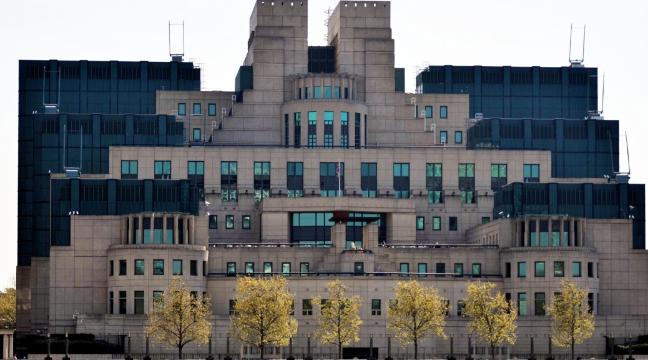
The hidden world of betrayal, espionage and cover-ups in post-Second World War Britain has been uncovered in official files made public for the first time.
Dozens of MI5 and Foreign Office files have been released to the National Archives in Kew, west London, revealing the stories behind vanishing spies and government scandal.
Here’s 7 shocking spy secrets revealed in the declassified files.
1. Notorious Soviet spy Kim Philby desperately tried to save his own skin after the flight of his two colleagues.

Maclean, left, and Burgess, right
Philby and fellow spies Guy Burgess and Donald Maclean were recruited by Russia’s KGB while studying at Cambridge in the 1930s and became part of a major spy ring within the Foreign Office.
But in May 1951 Burgess and Maclean slipped out of the country as an investigation closed in on them. This left their associates, including senior MI6 officer Philby, under suspicion.
In June, records show Philby messaged MI6 chief Sir Stewart Menzies to inform him of Burgess’ suspicious behaviour, in an attempt to shift attention from himself.
“There is, I am afraid, very little doubt that Burgess had available the essential requirements of an espionage agent,” Philby wrote.
2. MI6 could have exposed Philby as a double agent much sooner.

Notorious spy Kim Philby
MI6 failed to investigate one of Philby’s most treacherous acts in September 1945 – exposing Russian defector Constantin Volkov to the KGB, who had offered to reveal details of some 250 Soviet agents working in Britain.
By a stroke of luck, Philby was assigned to the case and delayed it to give the KGB time to act. Volkov was whisked back to Russia from where he was hiding in Turkey in a Soviet military aircraft.
MI6 assumed he had been tortured and murdered, but Menzies dismissed the idea of an investigation into the case.
3. A mistake by Philby could have hastened the fall of the Cambridge spy ring.

The desk in Philby’s Moscow flat
In the late 1940s, US codebreakers reopened the hunt for a spy at the British embassy in Washington who passed secret wartime telegrams between Winston Churchill and President Roosevelt to the Russians.
New files show in November 1949 Philby pointed out that shortly before the war Russian defector General Walter Krivitsky had revealed there was an unnamed Foreign Office source with a “first class” education reporting regularly to the Soviets.
Philby may have been trying to protect himself, but his tip led his colleague Maclean to be included in a shortlist of just six names who fitted the bill.
4. The US just couldn’t believe the government had employed Burgess and Maclean.

Portraits of the two missing diplomats, complete with descriptions
Papers reveal that US officials were incredulous that the two drunken characters could be employed in the Foreign Office and demanded that Britain “clean house”.
Burgess publicly revealed the identities of two British intelligence officers during a drunken row in Tangiers while Maclean smashed up the flat of a female staff member of the US embassy in Cairo.
Maclean had once even admitted he was a communist while drunk, but was not taken seriously.
5. The government feared the body of the missing Royal Navy diver – who was the inspiration for Ian Fleming’s James Bond adventure Thunderball – would be used for propaganda if found

Lionel “Buster” Crabb
Lionel “Buster” Crabb disappeared on April 19 1956 while spying on a warship in Portsmouth harbour that had brought Soviet leaders Nikita Khrushchev and Nikolai Bulganin to the UK on a diplomatic visit.
It emerged people outside the mission knew Crabb was diving in Portsmouth, and he had been booked into a hotel using his real name.
Unseen government papers now reveal officials felt it most likely his body was still in the water after being killed by Russian counter-measures and there were fears “if it was aboard the Russian ship, they might produce it for propaganda purposes at an opportune moment either dead or alive, or they might dispose of it after leaving Portsmouth”.
6. Tory peer Robert Boothby and East End gangster Ronnie Kray went to “homosexual parties” together and were “hunters” of young men.

Robert Boothby was linked with an East End gangster
Boothby, a popular TV presenter and former MP, was accused of having an affair with notorious criminal Kray after a photo was leaked of the pair together in 1964.
The story sent Westminster in a spin and Boothby fiercely denied the claims. But declassified files reveal the pair were closer than he would have liked to admit.
An MI5 report reveals Boothby’s chauffeur and lover, a young “Shoreditch-born former boxer” named Leslie Holt, introduced the peer to Ronnie and the two went to “homosexual parties” together.
7. But MI5 didn’t think the pair’s friendship was a threat to national security.

The Kray twins – Ronnie, left, and Reggie, right
Roger Hollis, director general of MI5, said there was “no security issue involved” as Boothby didn’t have an official position that could allow him to compromise government secrets.
In 1968 the Krays were later sentenced to life imprisonment for murder, but luckily for Boothby the scandalous relationship was kept under wraps.
http://home.bt.com/news/news-extra/7-shocking-spy-secrets-revealed-by-mi5-files-11364012478813

No comments:
Post a Comment